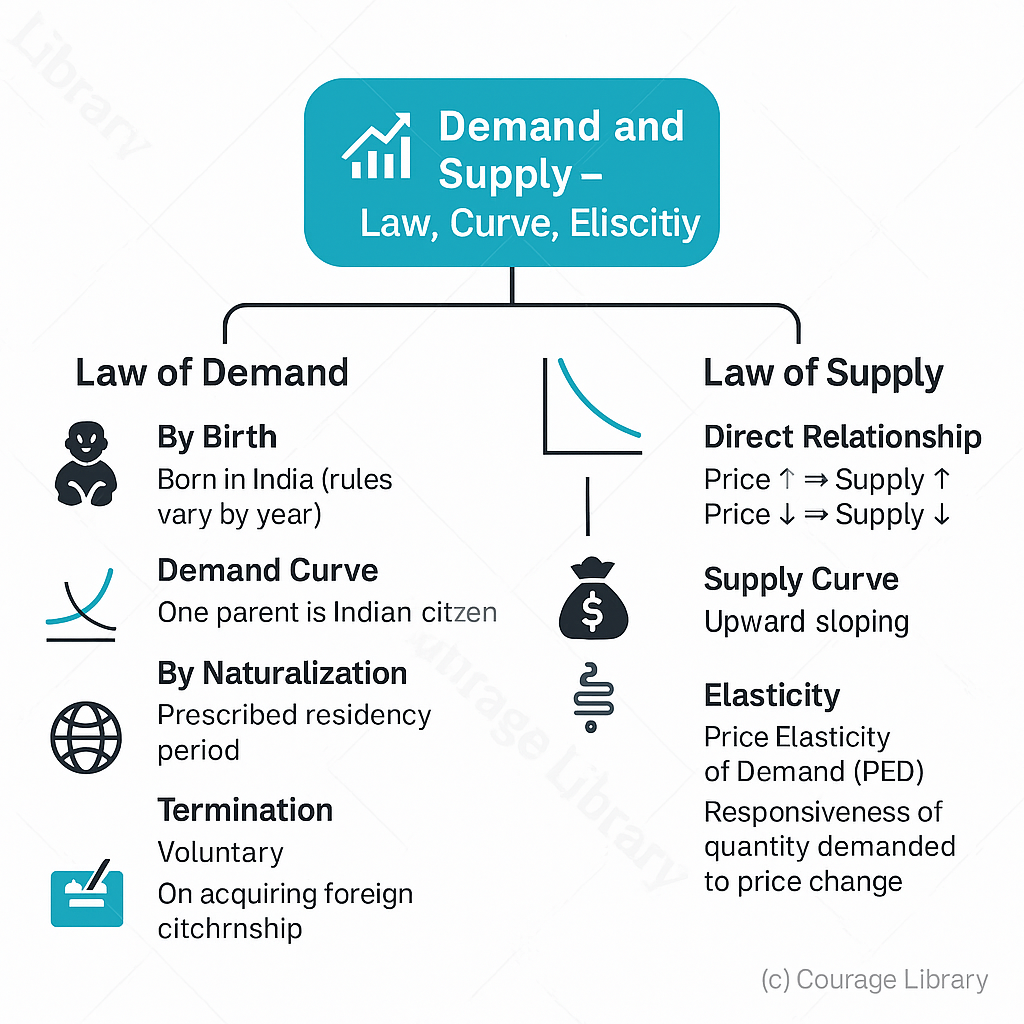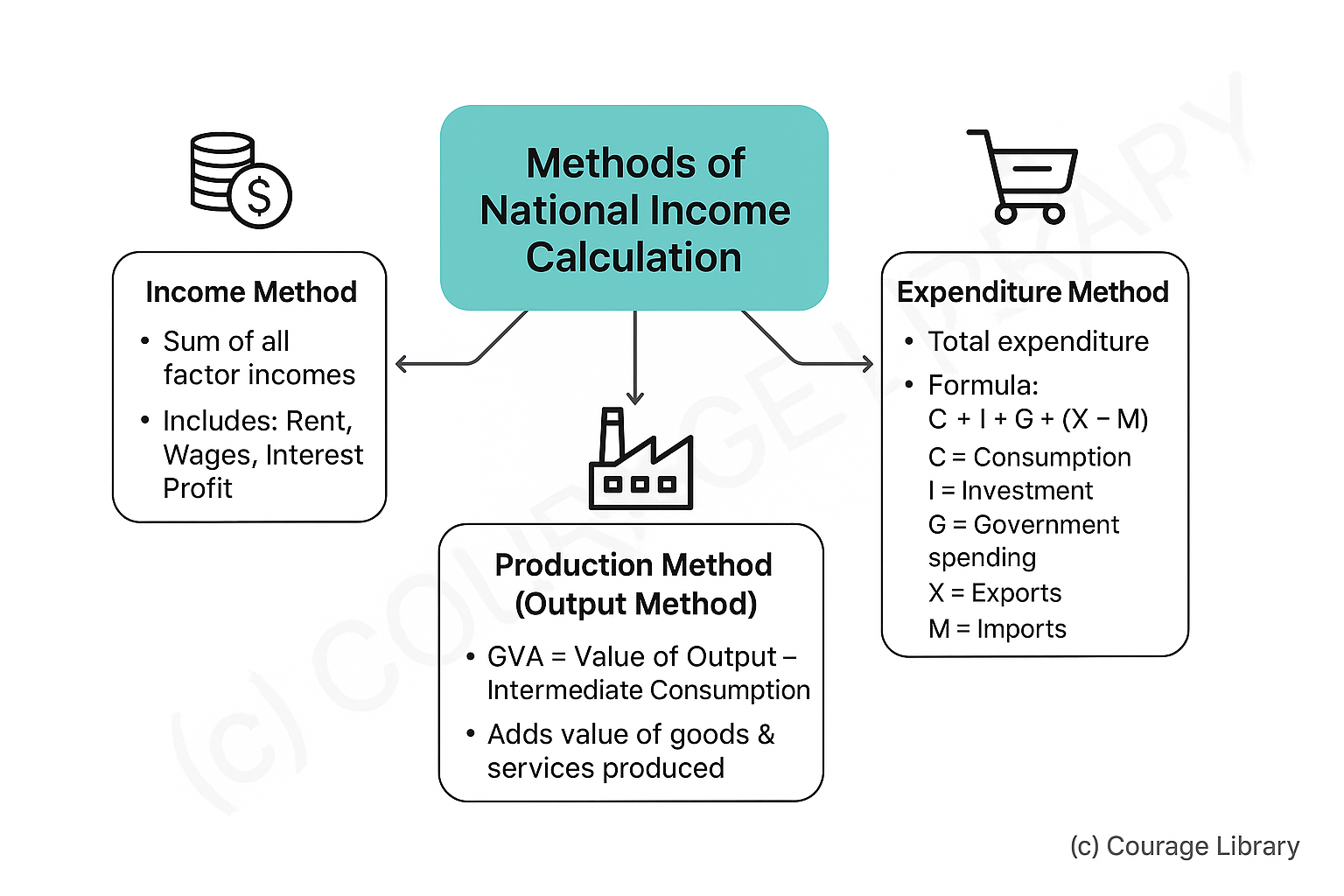SSC CGL - Detailed Guide 2025
Self-Paced Course

Basic Concepts of Economics
Reference: Lucent GK, NCERT Class 6–12
Definition, Types & Scope of Economics
| Category | Description |
|---|---|
| Economics (General) | Study of how scarce resources are allocated to fulfill unlimited wants. |
| Microeconomics | Deals with individual units (consumer, firm, market). |
| Macroeconomics | Deals with the economy as a whole (inflation, national income, unemployment). |
Branches: Consumption, Production, Distribution, Exchange, Public Finance.
Nature: Positive (what is) vs. Normative (what ought to be)
Micro vs Macro Economics
| Basis | Microeconomics | Macroeconomics |
|---|---|---|
| Focus | Individual units (firm, consumer) | Whole economy (aggregates) |
| Tools | Demand, supply, price mechanism | National income, inflation, monetary policy |
| Example | Price of a product | General price level |
Demand and Supply – Law, Curve, Elasticity
Law of Demand
- Inverse relationship between price and quantity demanded, ceteris paribus.
- | Price ↓ ⇒ Demand ↑ | Price ↑ ⇒ Demand ↓ |
- Demand Curve: Downward sloping
- Exceptions: Giffen Goods, Veblen Goods
Law of Supply
- Direct relationship between price and quantity supplied.
- | Price ↑ ⇒ Supply ↑ | Price ↓ ⇒ Supply ↓ |
- Supply Curve: Upward sloping

Elasticity
| Type | Meaning | Importance |
|---|---|---|
| Price Elasticity | % change in quantity / % change in price | Tax policy, pricing strategies |
| Income Elasticity | Change in quantity with income change | Identifying normal vs. inferior goods |
| Cross Elasticity | Change in quantity of Good A due to price change in Good B | Substitute vs. Complementary |
Utility – Total and Marginal Utility
| Concept | Definition |
|---|---|
| Total Utility (TU) | Total satisfaction from consuming a good |
| Marginal Utility (MU) | Additional satisfaction from consuming one more unit |
| Law of Diminishing Marginal Utility | MU decreases as more units are consumed |
MU = ΔTU / ΔQ
When MU becomes zero → TU is maximum.
National Income Concepts
Basic Terms
| Term | Meaning |
|---|---|
| GDP | Gross Domestic Product – Total value of goods/services within a country |
| GNP | Gross National Product – GDP + Net income from abroad |
| NNP | Net National Product = GNP – Depreciation |
| NDP | Net Domestic Product = GDP – Depreciation |
Real vs. Nominal: Real adjusted for inflation; Nominal is current price.
Market Price vs Factor Cost
| Term | Explanation |
|---|---|
| Market Price | Includes indirect taxes, excludes subsidies |
| Factor Cost | Excludes indirect taxes, includes subsidies |
| Formula | Factor Cost = Market Price – Indirect Taxes + Subsidies |
Methods of National Income Calculation
- Income Method: Sum of all factor incomes (Rent, Wage, Interest, Profit)
- Expenditure Method: Total expenditure (C + I + G + (X − M))
- Production Method: GVA (Gross Value Added) = Value of output – Intermediate consumption

Inflation and Deflation
Inflation
Persistent rise in the general price level of goods/services.
| Type | Description |
|---|---|
| Demand-Pull Inflation | Excess demand over supply |
| Cost-Push Inflation | Rising cost of production (e.g., wages, oil) |
| Core Inflation | Excludes food and fuel prices |
Effects: Reduces purchasing power, affects savers.
Deflation
Persistent fall in the general price level.
Leads to: Unemployment, low demand, recession

CPI vs WPI
| Indicator | Consumer Price Index (CPI) | Wholesale Price Index (WPI) |
|---|---|---|
| Focus | Retail prices paid by consumers | Wholesale prices of goods |
| Base Year (India) | 2012 | 2011-12 |
| Use | Inflation targeting by RBI | Policy formulation |
Poverty and Unemployment
Types of Poverty
| Type | Explanation |
|---|---|
| Absolute Poverty | Income below the minimum requirement for survival |
| Relative Poverty | Comparison of income levels among population |
| Urban/Rural Poverty | Poverty classified by residence |
Poverty Line in India decided by NITI Aayog (earlier Planning Commission)
Types of Unemployment
| Type | Description |
|---|---|
| Structural | Due to mismatch in skills and job opportunities |
| Seasonal | Found in agriculture (not employed year-round) |
| Disguised | More people working than needed (common in Indian farms) |
| Cyclical | Due to business cycle downturns |
| Frictional | Temporary, during transition between jobs |
| Educated | Degree-holders with no employment |
Developed By Roopasree Challa
Next
Start Your SSC CGL Journey Now!
Join Courage Library to experience disciplined study and expert support.
Be a Couragian!